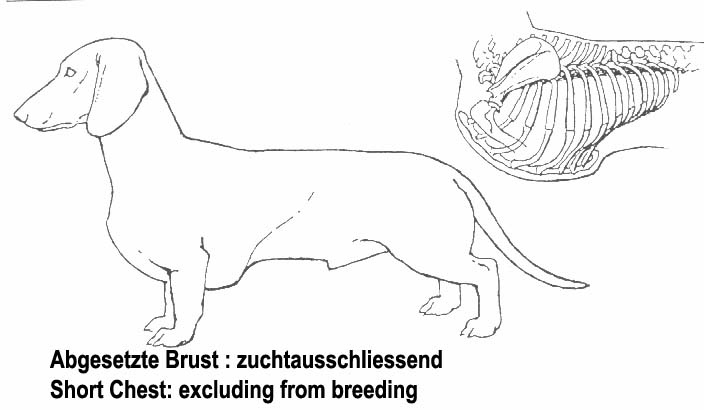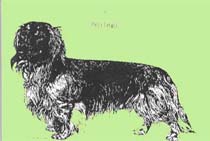THE STANDARD OF THE TECKEL, ALSO DACHSHUND OR DACKEL
STANDARD FCI Nº 148 / 4.12.1998
The Dachshund, also called Dackel or Teckel is known since the Middle Age. Starting by braques, there have been breeded dogs especially indicated for the hunting below the ground. From these short-legged dogs resulted the dachshund which is recognized as a hunting dog breed for multiple purposes. He shows as well excellent results over the ground as of hunting the hare trace barking, making out hunting pieces or tracking wounded animals.The oldest breeding society for Teckels is the Deutsche Teckelklub e.V. founded 1888. By preserving the genetical health of the breed, eye or ear defects as well as ephileptical disease are not desired and have to be excluded of breeding. The Dachshund exists in three different sizes (Standard, Dwarf and Miniature) and in three different coat qualities (Shorthair, Wirehair and Longhair).
GENERAL APPEARANCEDefined as a dog with low body, short legs, long but well balanced and well muscled. The head must be carried erect with an expression of challenge and intelligence. Even though the relation of the short legs to his long body, he never has to seem a crippled dog, heavy or limited in his movements nor too light bodied, with the tipical differences of male and female.The proportions to consider when standing between the distance from the ground to the sternum and the sternum to the withers. It should be 1/3 of the sternum to the ground, and 2/3 of the withers to the sternum: the proportion length to hight of the whole body is about 1 to 1,8 . In this diagram we see the different distances from the ground to the sternum:
( Explanation:
1) Distance to the ground 1/4; too close to the ground.
2 ) Distance to the ground 1/3; correctl distance
3) Distance to the ground 2/5; too high
4) Distance to the ground 3/7; too high
The proportion of length must be in relation to the height. A dachshund that is too long will not have a correct back. A dachshund that is too short will remind us of a terrier.)BEHAVIOUR, CHARACTER (TEMPER)
Friendly, neither afraid nor aggressiv, with good temperament. A passionated, steady, fine nosed and quick hunting dog.
The head: Extended when viewed from above and from each side, decreasing proportionally towards the tip of the nose. The bones and the eyebrows are well pronounced.The cranium is slightly concave with very little stop (the less the better), terminating in the beginning of a nose that curves slightly upward.Mouth to be opened until the cave of the eyes.Jaws: strong upper and lower jaw developpment.Teeth: complete (42 teeth as of the teeth standard of dogs) with strong corner theeth correctly interlock. The scissors bite (upper teeth over lower teeth) actually is correct and preferred to the level bite (teeth edge to edge).
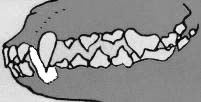

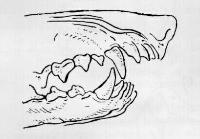 scissor bite ------- level bite ------Overschot --------Underschot
scissor bite ------- level bite ------Overschot --------Underschot
(Explanations: Scissors bite is correct. Level bite only obtains the qualification "very good".Undershot and overshot bites have to be automatically excluded from any conformation show and from breeding.Missing 4 or more premolars exclude the dog from receiving the rating 'good").
The lips are thin and taut, covering well the lower jaw.The eyes: Medium size, oval, situated on the side with an energetic but friendly expression, not stechend. The colour is strong dark brown, close to black for all coat colours. Glass eyes, partridge eyes, and pearl eyes are not defects in gray or dapples, but neither are they desired.
The colors:
1 - 4 desired for dark coats,
5 - 9 acceptable for reds and light coats,
9 - 15 not desirable,
16 is a glass eye.
The eyes of a dachshund should be almond shaped; large or round eyes give the dachshund a strange expression. Blue eyes are only tolerated in dapples, and always should reduce the rating by one grade in the final classification.
Ears. High placed and not too far forward, sufficiently but not too long and well rounded. Ears must not be sharp pointed or narrow nor folded. The front edge must touch the cheek.Neck: Long enough, muscular, without a double chin, lightly curved at the nape. Desirable necks are neither too short (not elegant) nor too long (swan neck).
The Body
Upper line: harmonious from the neck until the croup.
Withers: pronounced.
Back: The withers must be high and long, later continue straight and then show a slight curve at the kidneys.
Loin: stron, well musculated, sufficiently long.
Croup: slightly inclined.Chest: The breastbone is strong and well pronounced, enough so to cause dimples on each side. The front view of the thorax is oval. Viewed from any other position, we see fullness and width, guaranteeing the ample and correct development of the lungs and heart. The ribs point back. The correct angle and length of the shoulder and forearm cause the front legs to fall in a perpendicular plane from the thorax, coinciding with the lowest point of the chest.(Explanation: Defective alignment: the lowest point of the chest falls behind the front legs. In the ideal case, the chest line passes from the neck towards the keel of the chest with a pretty impulse. From there it descends harmoniously towards the lowest point of the chest, coincident with the position of the legs)Under Line: The under line curve of the abdomen will be slightly rising.The Tail: well-placed, with the insertion not too high, as a continuation of the back line. At the last third a light curve is allowed. (with all of the vertebrae free from deformity. )
Forehand and Hindquaters
ForehandGeneral: Strong muscled, well angulated, seen from the front, the frontlegs must be dry and straight, with strong bones and the paws correctly positioned. Shoulders: :Long shoulders correctly angled, hard and well muscled. The humorous has the same length as the shoulder blade, forming a right angle with it. Bones are strong and well muscled, fitiing tightly with the ribs while permitting free movement.Elbow: Neither turning inside nor outside.
Forearm: Short, but so long, that the distance from the sternum to the ground has about one third (1/3) of the distance from the sternum to the withers (2/3). As straight as possible.
Pastern and front leg articulation: Seen from side should not be too upright nor pointing too much forward.The foreleg should form a 90 degree angle with the femur.
Feet Closed and well rounded with strong and solid pads. Every foot has five toes, 4 of which are used to tread.
HindquatersGeneral : Strongly muscled, in good proportion to the forehand, knee and hock strong angulated, hindquaters parallel, not too narrow nor too widespread.
Thigh: Has to be from good length and strongly muscled.
Knee-joint: Wide and strong with pronounced angulation.
Second thigh: Short, nearly in right angle to the upper thigh, well muscled.
Hock: Strong and well angulated
Metatarsal: Quite long, movable to the second thigh and slightly concave.
Back feet: With four well closed toes, well shaped. Perfectly standing on the ground.
MOVEMENTThe movement has to be wide, flowing and advancing, with a wide stride and strong push being at the same time the back line well supported. While moving, the tail should be the the harmonious contination of the top line, and worn slightly falling downwards. During the movement the forelegs and hindquaters have to move in parallel. In the front neither moving close nor "paddling", neither with toes turned inwards nor turned out. Hindquaters neither too narrow nor wide as cow hocks or with spread hacks.
Skin: taff and well closed to the body .
Below a perfect balanced teckel with correct angulations.
COAT
ShorthairHair: Must be dense, shiny, very close to the body, not showing bald spots anywhere.
Tail: Fine, well covered with hair, but not excessive. Some longe hairs on the lower side of the tail are not a defect.Colours:a) One-Colour: Red or light red, also permitted some black hair mixed in . Strong reds are favoured over the light reds or yellowish dogs. Also the dogs with stron black hair mixture belong in this parragraph. White spots are not desired, although a tiny blaze on the chest will not disqualify.b) Two-Colour: The base may be black or brown and must always be accompanied by tan (more or less intense) presenting two spots over the eyes, at both sides of the muzzle and under lip, in the inside of the ears, aat the front chest, in the inner side of the legs and the paws, around the anus, and a third of the underside of the tail. The nose and nails with black dogs have to be black, with brown dogs brown or black. White is not desirable but a small white spot is not excluding. The tan marks too widespread is not desired.c) Dapples: The base must always be the darker colour (black, brown or gray) with light spots spread irregularly. The spots must be small and coloured gray, brown, yellowish red or black. It is undesirable that a light background or dark spots dominate. A brindle dachshund is very rare and has thick dark stripes over a red or tan base. The nose and nails the same as the two-coloured dogs.d) other colours than the above mentioned.(Explanation: other colours than the mentioned, except the colour "wild boar" are not teckel colours and will not have a better qualification than "Good". Wild boar colourd shorthair teckels are not desired and will not have the qualification "Very good". White coloured teckels and creme coloured teckels are not desired and will not have the qualification of "Very Good".
Wirehair:Hair:Seen from far, they must look like a short hair dachshund. Except the muzzle, the eyebrows and ears, the coat will be of equal length all over the body , forming a thick and rough coat with undercoat. Aat the muzzle showing a good pronounced beard. The eyebrows are bushy. At the ears the hair is shorter as the body, nearly short. The tail hair with the same length all over.Colour: Regarding the colour of the coat, it is usually the colour of wild boar, otherwise the same colours as mentioned at the shorthair teckel.
Longhair:Hair:The coat is long and silky, with undercoat. The coat must be soft, flat on the body and shiny. The coat is longer above the throat, the body, the ears, and notably longer behind the legs, reaching the longest under the tail where it forms a beautiful flag.Colour: The same as the shorthaired Dachshund.
Measures and weight:
Standardteckel: thorax perimeter over 35 cm.
Dwarf: Up to 35 centimeters thorax perimeter at the age of 15 months.
Miniature: Up to30 centimeters thorax perimeter at the age of15 months.
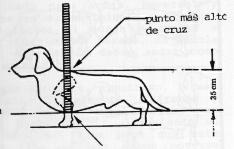 Weight : The only limitation is that they must not weigh more than 9 kg (20 pounds) as an adult.
Weight : The only limitation is that they must not weigh more than 9 kg (20 pounds) as an adult.
DefectsAny deviation from the above points has to be considered a defect which qualification will be in the exact relation to the grade of deviation.NEW !!
When there lack two PM1 (premolar 1) or both M3 (molar 3) it is not a fault.
If there lacks also to the two PM1 one M3 or both M3 and one PM1, than it is a defect for the qualifications.
Heavy Defects (these dogs do not obtain the qualification of "very good")- dogs with a weak appearance or too high or too narrow to the ground.
- other teeth defects than describes under excluding defects.
- pearl eyes in other than dappled teckels.
- teckels with the body hanging between the shoulders.
- saddle back or carp back.. - weak loin part.
- weak loin part.
- Teckels with the croup higher than the withers.
- chest (rib cage) too weak.
- under line pulled up as a greyhound.
- incorrect (upright) angulations of the forehand and hindquaters.
- narrow and too weak muscled hindquaters.
- cow hocked or barrel legs.
- feet turned inwards or turned too much outwards.
- open toes.
- plump movement, or swinging or short stride.
Correct hindquaters, cow hocked hindquaters, barrel legs:
Coat defects:Shorthair teckels:- hair too thin and poor, bare parts at the ears (lether ears), other body parts without hair.
- too much hair, hair quality too strong.
- tail with too much hair.
- black coloured teckels without tan.
Wirehair teckels:- soft hair, long or short.
- long hair spread in all directions from the body
- curled or ondulated hair.
- soft hair on the top of thehead.
- tail with hair as a flag.
- lacking beard.
- lacking undercoat.
- shorthaired
Longhair teckels:- hair of same length all over the body
- ondulated hair or rough hair.
- lacking of the tail hair forming a flag.
- lacking the long hair at the border of the ears.
- hair opening in two part to the sides at the back.
- too lang hair between the toes.
Excluding defects.- teeth with overshot or undershot or cross-shot.
- lower corner teeth too narrow.
- lacking of one or more Canini
- lacking of one or more Incisors.
- lacking of another tooth (premolar or molar) to the two PM1 and one M3 or two M3 and one PM1.
- short chest (see drawing below)
- all tail defects (see drawings below)
- very loose shoulders
- forearm knuckling over
- very tinid or agressiv temper.
- black colour without tan.
- white colour with or without tan.The males have to show two well developped testicles, which are complete descended in the testicle sack.(Monorchid and kryptorchid are excluding defects).
Short chest:Xifoides directed upward, breaking the harmony of the chest, causing the withdrawal of the ninth rib; this is an excluding defect for breeding.
Tail defects: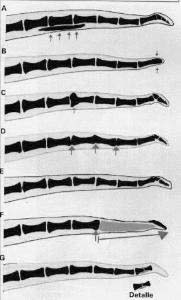 A) double vertebra, (very rare) makes the tail rigid
A) double vertebra, (very rare) makes the tail rigid
B) missing the last vertebra, normal are 18 to 22 vertebras
C) excessive calcification of a vertebra,
D) union of various vertebrae, causes the tail to be rigid
E) last vertebra as a hook.
F) missing various vertebraeTeckels with these hereditary defects are excluded from breeding.
G) accidentally broken vertebra (does not exclude breeding since this is not hereditary, but in Dog shows it has to be presented a certificat of the treatment by the veterinarian)
A)Correct tail - B)Hook tail - C)High tail - D) Set too low - E) Carried under the body.
..



